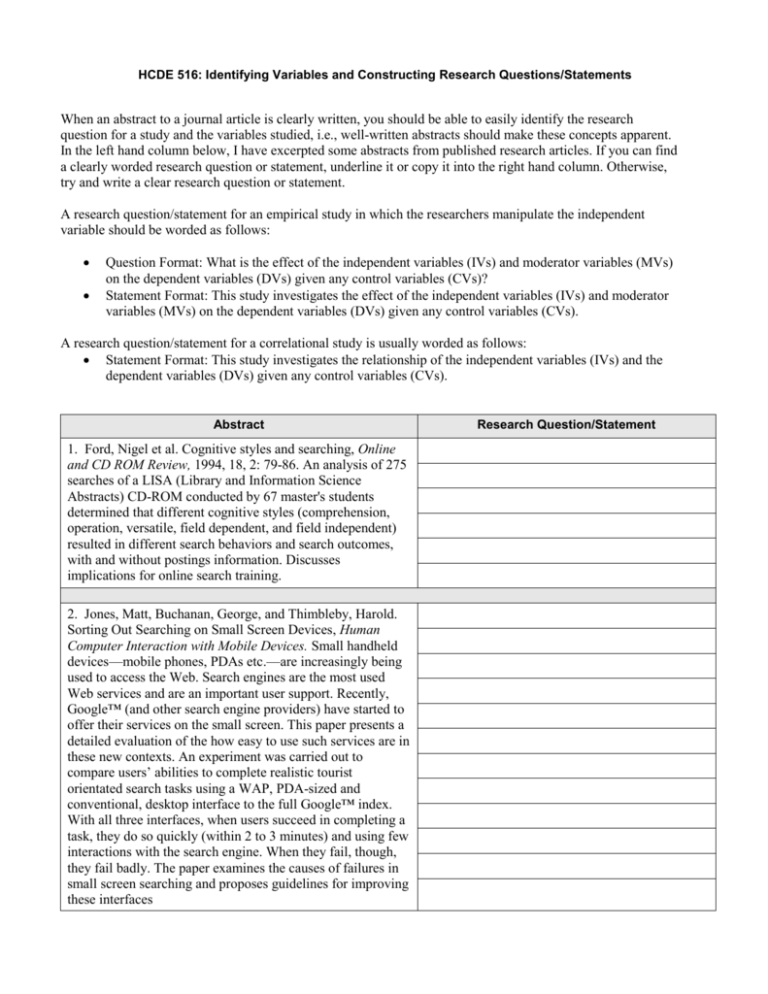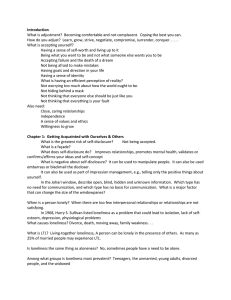Identifying Variables and Constructing Research Questions
advertisement

HCDE 516: Identifying Variables and Constructing Research Questions/Statements When an abstract to a journal article is clearly written, you should be able to easily identify the research question for a study and the variables studied, i.e., well-written abstracts should make these concepts apparent. In the left hand column below, I have excerpted some abstracts from published research articles. If you can find a clearly worded research question or statement, underline it or copy it into the right hand column. Otherwise, try and write a clear research question or statement. A research question/statement for an empirical study in which the researchers manipulate the independent variable should be worded as follows: Question Format: What is the effect of the independent variables (IVs) and moderator variables (MVs) on the dependent variables (DVs) given any control variables (CVs)? Statement Format: This study investigates the effect of the independent variables (IVs) and moderator variables (MVs) on the dependent variables (DVs) given any control variables (CVs). A research question/statement for a correlational study is usually worded as follows: Statement Format: This study investigates the relationship of the independent variables (IVs) and the dependent variables (DVs) given any control variables (CVs). Abstract 1. Ford, Nigel et al. Cognitive styles and searching, Online and CD ROM Review, 1994, 18, 2: 79-86. An analysis of 275 searches of a LISA (Library and Information Science Abstracts) CD-ROM conducted by 67 master's students determined that different cognitive styles (comprehension, operation, versatile, field dependent, and field independent) resulted in different search behaviors and search outcomes, with and without postings information. Discusses implications for online search training. 2. Jones, Matt, Buchanan, George, and Thimbleby, Harold. Sorting Out Searching on Small Screen Devices, Human Computer Interaction with Mobile Devices. Small handheld devices—mobile phones, PDAs etc.—are increasingly being used to access the Web. Search engines are the most used Web services and are an important user support. Recently, Google™ (and other search engine providers) have started to offer their services on the small screen. This paper presents a detailed evaluation of the how easy to use such services are in these new contexts. An experiment was carried out to compare users’ abilities to complete realistic tourist orientated search tasks using a WAP, PDA-sized and conventional, desktop interface to the full Google™ index. With all three interfaces, when users succeed in completing a task, they do so quickly (within 2 to 3 minutes) and using few interactions with the search engine. When they fail, though, they fail badly. The paper examines the causes of failures in small screen searching and proposes guidelines for improving these interfaces Research Question/Statement Abstract Research Question/Statement 3. Spruijt, S., and Jansen, C. The influence of task and format on reading results with an online text, IEEE Transactions on Professional Communication, 1999, 42: 2, 92-99. The aim of the study was to map the influence of reading task and text format on reading results with an online text. To this purpose, an experiment performed by S. Gordon et al. (1988) was replicated and enhanced. In four conditions, subjects were given a reading task (summarize or answer specific questions) and an online text (linear or hypertext format). In all conditions, both text and task were administered through the World Wide Web, After the subjects had completed their reading, all were given the same assignment: make a summary and answer specific questions. No significant main effects of the independent variables (format and task) were found on the performance of the subjects. There proved to be a significant interaction effect, however, on the completeness of the summaries. The most thorough summaries were written by subjects who were told before the experiment that they would have to summarize the text, and who were presented with the text in a linear version. As far as reading time was concerned, there was a significant difference between the format conditions: reading the text in linear format took more time than reading the text in hypertext format. 4. Hinckley, K., Cutrell, E., Bathiche, S., and Muss, T. Quantitative analysis of scrolling techniques, Proceedings of Conference on Human Factors in Computing Systems, CHI 2002. We propose a formal experimental paradigm designed to help evaluate scrolling interaction techniques. Such a method is needed by interaction designers to quantify scrolling performance, thereby providing a tool to evaluate and improve upon new techniques. We systematically vary the scrolling distance as well as the required tolerance of scrolling. Distance and tolerance are the parameters of Fitts' Law, which traditionally has been applied to the evaluation of pointing devices in tasks involving rapid, aimed movement to visible targets. Scrolling involves acquisition of targets well beyond the edges of the screen, yet Fitts' Law models our experimental data very well. We apply our paradigm to the IBM ScrollPoint and the IntelliMouse Wheel. Our experimental approach reveals a crossover effect in performance versus distance, with the Wheel performing best at short distances but the ScrollPoint performing best at long distances. We also demonstrate that the performance of the Wheel can be significantly improved using an acceleration algorithm. These results show that our approach yields a practical and rigorous method for the evaluation of scrolling techniques. 2 Abstract Research Question/Statement 5. Scealy, Marita, Phillips, James G., Stevenson, Roger. Shyness and Anxiety as Predictors of Patterns of Internet Usage, CyberPsychology & Behavior December, 2002, 5(6): 507-515. The Internet has the potential to empower or isolate. Shyness and anxiety may potentially influence the extent to which people avail themselves of Internet services such as email, chat rooms, information searches, entertainment, and commerce. To understand how personality moderates Internet usage, 177 participants completed an Internet Use Survey, the Social Reticence Scale, and a Trait Anxiety Inventory. Shyness, anxiety, gender, and academic achievement were employed within separate multiple regressions to predict forms of Internet usage. The use of email and chat-rooms was not related to shyness or anxiety, suggesting that shyness or anxiety does not pose an obstacle to these Internet applications. Males were more likely to use the Internet for downloading entertainment. Shy males were more likely to use the Internet for recreation/leisure searches. Highly educated males were more likely to use the Internet for banking and paying bills. Although shyness or anxiety does not seem to modify the communicative functions of the Internet, it may influence people's use of other recreational applications. 3











